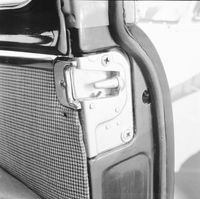50 Years of Contained Safety: The Mercedes-Benz Wedge-Pin Door Lock
STUTTGART, GERMANY – July 16, 2009: It was 50 years ago that a special Daimler-Benz patent made its series production debut; a feature that was to become a key advancement in passive car safety – the wedge-pin door lock.
The innovative lock, featuring two safety detents, prevented vehicle doors from bursting open or jamming shut in the event of an accident.
In vehicles with older locks fitted, doors were known to spring open even as a result of relatively harmless collisions, often resulting in occupants being thrown out of the vehicle, since restraining or safety belts were not commonplace at the time.
Some time earlier, numerous experiments had resulted in the first safety door lock, a pin lock, with which Mercedes-Benz reduced these risks considerably. This design was registered by the German Patent Office under No. 827 905 as “A locking mechanism, especially for motor vehicle doors” on April 23, 1949. In serious accidents, however, and particularly in the event of a rollover, the lock did not prevent doors from bursting open.
This problem was remedied by a new wedge-pin door lock featuring two safety detents. This lock design kept doors closed under all circumstances, thus ensuring complete stability of the passenger compartment and protecting the survival space for driver and passengers.
After various design stages, the wedge-pin door lock was finally patented as “a pin lock, especially for motor vehicles” in July 1958. The wedge-pin lock made its debut in a production model in 1959 in the Mercedes-Benz 220 (W 111), the world’s first passenger car to feature a holistically designed safety body.
A combination of several innovations made the “tail-fin” – as this model series became more familiarly known – a milestone in passive safety.
In addition to a rigid passenger cell, front and rear crumple zones and the wedge-pin door lock, these innovations also included a redesigned interior, in which all hazardous corners and edges had been removed.
The 111 model series was therefore the world’s first passenger car with an integrated safety body.
Innovations such as these eventually led to the current forward-looking integrated safety concept of Mercedes-Benz. This concept for the first time establishes an interrelationship between aspects of passive and active safety – marking a further significant step on the road to accident-free driving.



